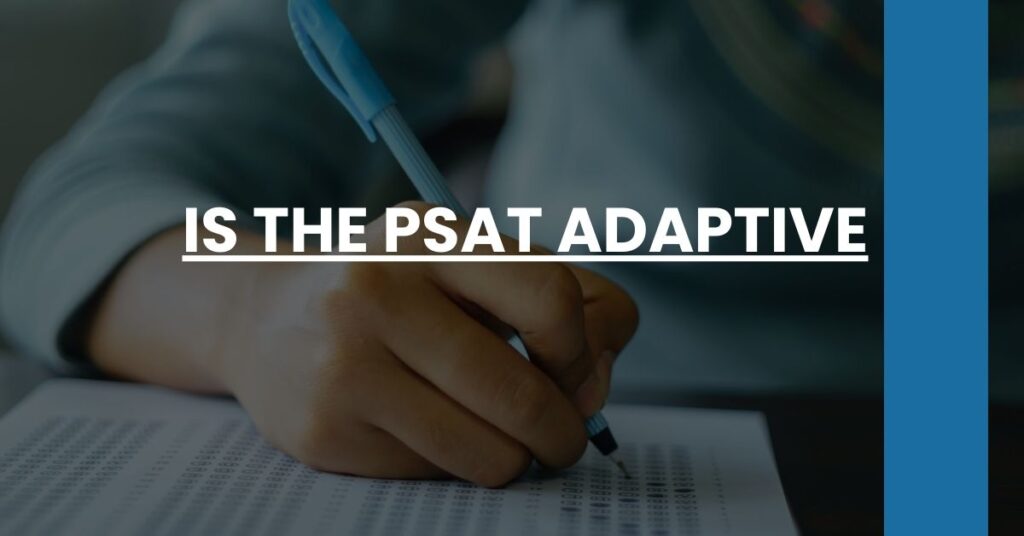The PSAT is not an adaptive test. It maintains a consistent structure with predetermined questions, unlike tests that adjust their difficulty level in response to the test-taker’s performance.
In the PSAT, all students face the same spectrum of question difficulty, allowing a direct comparison of results.
If you’re wondering whether to prepare differently for the PSAT because of adaptive features—don’t. Your study strategy can remain the same as you would for any other standardized test with a set pattern.
Despite its non-adaptive nature, understanding the format of the PSAT is crucial. So, ready to maximize your PSAT performance? Read on!
Note: This introduction is designed for an article that aims to provide the reader with a direct answer to their query while also encouraging them to engage with the rest of the content for additional insights and preparation strategies.
- Understanding the PSAT: A Primer
- The Concept of Adaptive Testing
- Analyzing the PSAT Format
- Comparing the PSAT to Adaptive Tests
- The Transition to Digital Testing
- Myths and Misconceptions About the PSAT
- Preparing for the PSAT: Strategies and Tips
- The Future of Standardized Testing: Is Adaptivity the Next Step?
- Conclusion: The PSAT and the Landscape of Standardized Testing
Understanding the PSAT: A Primer
If you’ve come in search of an answer to whether the PSAT is adaptive, let’s start by exploring what this test encompasses. The Preliminary SAT, more commonly known as the PSAT, is a standardized test that serves as both a practice round for the SAT and as a qualifying assessment for the prestigious National Merit Scholarship Program. It’s designed specifically for high school sophomores and juniors to showcase their skills in reading, writing, and math—all critical areas that indicate college readiness.
At its core, the PSAT has a fixed blueprint. It consists of four sections:
- Evidence-Based Reading: This is where your comprehension and interpretation skills are put to the test.
- Writing and Language: Grammar and usage know-how will come in handy here.
- Math (with calculator): Problem-solving and data analysis questions make up this segment.
- Math (without calculator): This challenges your mathematical abilities sans technological aids.
With a total of 139 questions and a score range of 320 to 1520, it’s designed to mirror the SAT to some extent, helping students get a feel for what the ‘big test’ will be like. However, specifics matter when we’re comparing it to adaptive tests, so it’s crucial to get acquainted with the traditional, linear format of the PSAT, which you can find on the College Board’s official outline for the PSAT/NMSQT Structure.
The Concept of Adaptive Testing
Before we delve deeper, let’s clarify what ‘adaptive’ truly means in the context of testing. Adaptive testing, also known as computer-adaptive testing (CAT), adjusts the difficulty of questions as you progress through the examination based on your previous answers. It’s like a video game that gets harder the better you play or easier if you’re struggling. Imagine taking a math test that serves up a tougher problem each time you nail the previous one. That’s adaptive testing for you.
This personalization to a student’s ability level can provide a more accurate assessment of their knowledge. The Graduate Record Examinations (GRE) and the Graduate Management Admission Test (GMAT) are prominent examples of such tests. To grasp the intricacies behind this methodology, the nuanced explanation of computer-adaptive tests might be something you’d want to explore further.
Analyzing the PSAT Format
When considering is the PSAT adaptive?, understanding its format is key. The questions presented in the PSAT are predetermined and do not shift in difficulty based on your performance. Essentially, whether you’re answering every question correctly or facing challenges, the next question will remain the same.
Scoring: Each correct answer nets you one point, no points are deducted for incorrect answers, and your raw score is converted into a scaled score.
Time Management: With the test clocking in at 2 hours and 45 minutes, pacing yourself is essential as you tackle each section within its allotted time frame.
The PSAT’s static nature enables all test-takers to encounter the same set of questions under similar test-taking conditions. This standardization is a foundational quality of the exam, contrasting vastly from how an adaptive test operates.
Comparing the PSAT to Adaptive Tests
The question, is the PSAT adaptive? hinges on this key comparison. As outlined, the PSAT follows a non-adaptive, linear path, dissimilar to an adaptive exam. The very essence of adaptive testing is to craft a unique trajectory for each student based on their performance, promptly responding to their answer choices. If the PSAT were adaptive, your initial responses would influence the difficulty of subsequent questions. However, in reality, every PSAT taker sees the same questions in the same order.
When you compare an adaptive test with the PSAT, staying grounded in your preparation is essential. For adaptive tests, you’d focus on honing your skills incrementally, prepping for that potential increase in difficulty. On the other hand, since the PSAT does not adjust in real-time, your strategy should be understanding and mastering a broad spectrum of topics with equal depth.
Beyond structure, another defining factor is the feedback loop. While adaptive tests may provide a more personalized assessment, the PSAT gives a generalized snapshot of your abilities, which is beneficial since it mirrors the SAT, itself a non-adaptive exam. Taking the PSAT seriously can set you up with tangible insights for the SAT. Even though it stays constant in its challenge level throughout, it delivers a comprehensive overview of where your strengths and improvement areas lie, as detailed by BestColleges.
With this understanding, you can now tailor your PSAT preparation without the concern of it being adaptive—a factor that simplifies your study approach, allowing you to focus on the full scope of content with equal intensity.
The Transition to Digital Testing
In recent years, the tide of standardized testing has shifted increasingly towards digital platforms. This transition isn’t just about swapping out pencil and paper for keyboards and screens; it represents the potential for profound changes in how tests are structured and delivered. For example, the College Board’s announcement of a digital version of the PSAT indicates that the future may hold more than just a change of format.
While digital testing could pave the way for adaptive features, as of now, the PSAT remains non-adaptive. However, with this shift to digital, it’s natural to wonder if one day you might log in to find that the PSAT has embraced the adaptive testing model. Although currently the answer to “is the PSAT adaptive?” is a clear “no,” it’s essential to stay informed about potential changes that could affect your preparation strategy.
Moving to digital formats offers various advantages like easier test-taking logistics and potentially more robust security features. For now, however, your focus should remain on acing the traditional, static PSAT format.
Myths and Misconceptions About the PSAT
Let’s address some myths and misconceptions that might cloud your understanding of the PSAT. You might have heard rumors that the PSAT is adaptive or that it doesn’t count toward your college readiness assessment. It’s crucial to discard these falsehoods.
The PSAT is a critical step on your journey towards college. It’s a standardized test that gauges your readiness and can highlight your potential as a National Merit Scholar. Furthermore, understanding that it is not adaptive allows you to approach your preparation with a clear mindset.
While common misconceptions about the PSAT abound, staying focused on the fact that the test has a set structure with non-adapting questions ensures that you’ll be ready for what actually lies ahead.
Preparing for the PSAT: Strategies and Tips
Since “is the PSAT adaptive?” is off the table, how should you gear up for this exam? Fret not; with a bit of planning and the right strategies, you’ll be ready to tackle those fixed-format questions head-on.
- Familiarize Yourself: Knowledge is power. Know the PSAT’s format inside and out. Understand the kinds of questions you’ll face and the topics they’ll cover.
- Practice, Practice, Practice: Take as many practice tests as you can. This will not only hone your test-taking skills but also improve your timing – an indispensable part of standardized test success.
- Focus on Weak Areas: Identify where you’re struggling and devote extra time to those areas. A balanced skill set across all sections will serve you well.
- Develop Test-Taking Strategies: Learn to recognize question types and the strategies that work best for each. Being efficient with your problem-solving approach is just as valuable as knowing the material.
Quality Resources: Utilize the best study guides and resources available. Remember that solid preparation comes from solid materials.
- Stay Updated: Though the PSAT isn’t adaptive now, it’s undergoing changes. Keep a watchful eye on updates from the College Board as you might need to tweak your strategies if the format evolves.
Approach your PSAT preparation with the confidence that, for now, every question holds equal weight and opportunity. This is your chance to shine uniformly across the board.
The Future of Standardized Testing: Is Adaptivity the Next Step?
The digital evolution suggests that adaptive testing may play a more significant role in the future of standardized tests. And yet, the question remains: will the PSAT eventually become adaptive?
While we can’t see the future, it’s evident that the standardized testing landscape is in flux. The move to digital by the College Board could be a precursor to adaptive testing elements being introduced. Keep abreast of developments by visiting sites like TPCurrent, as these changes could dictate different preparation tactics.
As the world of education technology progresses, the potential for adaptivity in exams like the PSAT cannot be dismissed. Stay engaged with the community and resources provided by the College Board for the latest updates.
Conclusion: The PSAT and the Landscape of Standardized Testing
To sum up, “is the PSAT adaptive?” The answer is no, but the realm of standardized testing is not immune to change. The PSAT currently remains a bastion of traditional, linear exam formats, offering a predictable and fair assessment for all students who sit for it.
But as you have learned, the educational landscape does not stand still, and neither should you. Embrace the constancy of the current PSAT to guide your preparation whilst remaining open to the winds of change that may one day steer the PSAT toward adaptivity.
Keep an eye on the horizon for updates and always be ready to adapt your study strategies to stay ahead. Remember, the path to academic success is not just about mastering the material—it’s also about navigating the ever-evolving world of standardized testing with agility and foresight.

